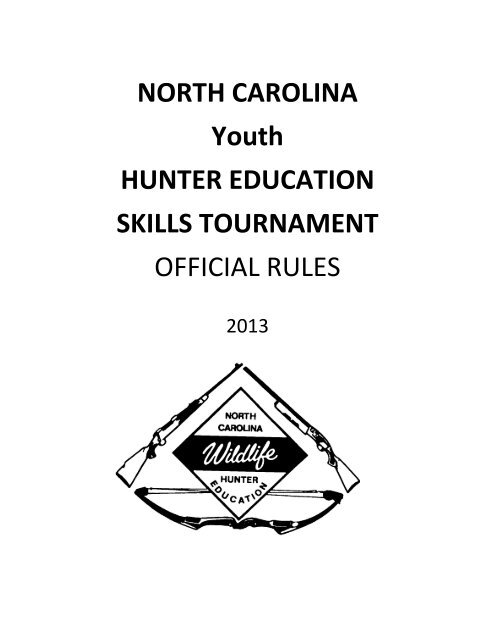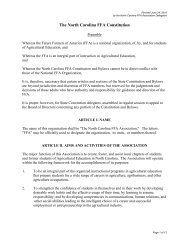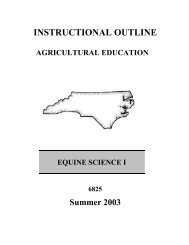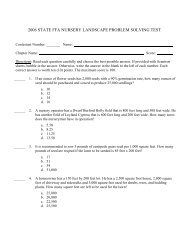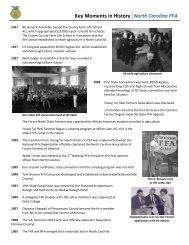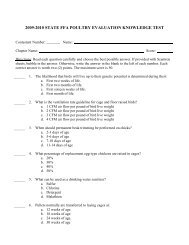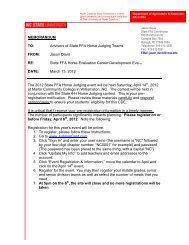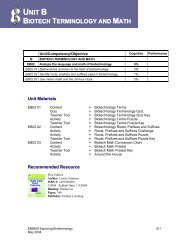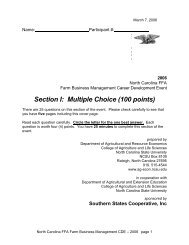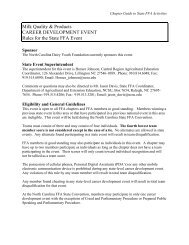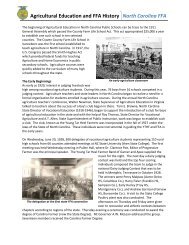OFFICIAL RULES - NC FFA
OFFICIAL RULES - NC FFA
OFFICIAL RULES - NC FFA
You also want an ePaper? Increase the reach of your titles
YUMPU automatically turns print PDFs into web optimized ePapers that Google loves.
NORTH CAROLINA<br />
Youth<br />
HUNTER EDUCATION<br />
SKILLS TOURNAMENT<br />
<strong>OFFICIAL</strong> <strong>RULES</strong><br />
2013
Rev. 9/12<br />
<strong>NC</strong> Wildlife Resources Commission<br />
Division of Enforcement<br />
Raleigh, <strong>NC</strong><br />
1
Rev. 9/12<br />
NORTH CAROLINA<br />
HUNTER EDUCATION TOURNAMENT <strong>RULES</strong><br />
A student/team competition in shotgun, archery, small bore rifle, and hunter skills.<br />
PLEASE NOTE: Any items in these rules in Red Type are additions or changes from the previous year.<br />
PURPOSE AND OBJECTIVES<br />
1. To promote the Hunter Education Program in the public and private schools.<br />
2. To promote public awareness of the Hunter Education Program in North Carolina.<br />
3. To encourage the Hunter Education graduate to go beyond the basics by developing their knowledge<br />
and skills in all areas of hunting experience, which will result in a safer and more responsible sportsman.<br />
4. To offer the young people of our state a positive experience in all disciplines of the shooting sport.<br />
5. To experience and learn a variety of legal hunting methods, its efficiency, operation and effectiveness.<br />
This can enable the student to evaluate the safest, most comfortable and effective equipment that can<br />
be used to hunt and/or target shoot.<br />
6. To promote the safe sport of hunting and shooting.<br />
ELIGIBILITY<br />
1. Schools must teach or offer the Basic or Advanced Hunter Education Course in the school to be eligible<br />
to send a team to the tournament. Home Schools may participate provided they do so as a Home<br />
School Association. 4-H Team may participate in a school attendance zone where a public school team<br />
does not exist. All members of a 4-H Team must reside within the same school attendance zone.<br />
Alternatively a 4-H team may be made up from members that attend the same school.<br />
2. Teams must consist of five (5) members for each event. Teams must compete in all events. The same<br />
five (5) members may compete in all events or a school may have a maximum of twenty (20)<br />
participants. Teams are encouraged to shoot and/or participate as a team in the District Tournament<br />
and are required to shoot as a team at the State Tournament. Teams that can only field four (4)<br />
members will be given consideration to compete but must be approved prior to competing. Notification<br />
must be made to the State Coordinator or his designates for approval.<br />
3. Teams may bring as many alternates as deemed necessary. If a contestant for any legitimate reason<br />
cannot complete any phase of the competition, his or her coach may appoint an alternate (WITH THE<br />
APPROVAL OF THE TOURNAMENT COMMITTEE) to replace him or her. Any completed activity by the<br />
excused competitor will be counted. Any activity started must be completed by that contestant.<br />
2
Rev. 9/12<br />
Alternates may not compete as a result of disqualification with the exception of an individual<br />
disqualified due to the pre-event safety inspection.<br />
4. Participants must be a member of a school team or 4-H team, a full-time student in that school (if on a<br />
school team), a hunter education graduate prior to the District Tournament, and have not received a<br />
high school diploma. There will be two (2) divisions.<br />
a. SENIOR category: Full-time student who has not yet graduated from high school.<br />
b. JUNIOR category: An elementary school that contains up to and including the 8 th grade or a<br />
middle school student as defined by the standard course of study for the school district in which<br />
the school is in. May not have reached the age of 16 by the day of the State Tournament held on<br />
the 4 th Saturday in April each year. If the 4 th Saturday falls on Easter weekend, the Tournament<br />
will be held the following weekend.<br />
5. A team must compete and qualify within their own District Tournament held before April 1 to be eligible<br />
to complete in the State Tournament. The team MAY NOT compete in more than one District<br />
Tournament. (Any exception to school wanting to complete outside their District MUST BE APPROVED<br />
BY THE HUNTER EDUCATION ADVISORY COMMITTEE).<br />
a. A maximum total of 54 teams (including both junior and senior teams) will be invited to the<br />
State Tournament.<br />
1. Senior Category: Each district conducting a tournament will be allowed to bring their<br />
top three (3) Senior schools (one team per school) that score a minimum of 3,375<br />
points in their District Tournament. Each district may send the district champion and<br />
runner-up, regardless of points.<br />
2. Junior Category: Each district conducting a tournament will be allowed to bring their<br />
junior champion and runner-up, regardless of points, and up to three (3) junior schools<br />
(one team per school) per district that score at least a minimum of 3,000 points in their<br />
District Tournament.<br />
3. After this number has been determined, invitations will be issued to the next highest<br />
scoring teams (who have scored a minimum of 3,000 points in numerical order). The<br />
number of numeric draw teams would be divided between the senior and junior division<br />
teams based on a percentage derived by dividing the number of junior teams into the<br />
number of senior teams. Any extra draw slots would be given to the junior category.<br />
b. A junior may compete on a senior team. However, a junior could not compete on both junior<br />
and senior teams. If a junior competes on a senior team he or she is only eligible for senior<br />
individual awards and cannot receive any junior individual awards or assist on the scoring for the<br />
junior team awards.<br />
c. If a student from a middle school or elementary school is too old to compete on that schools<br />
junior team, they are eligible to compete on the high school team for that school attendance<br />
zone.<br />
d. District Individual Champions for Rifle, Shotgun, Archery, Hunter Skills and Overall Winner<br />
whose team do not receive a state tournament bid may be invited to compete in their<br />
3
Rev. 9/12<br />
respective event. These individual champions will only be able to compete in the events they<br />
won in the district tournament. Individual champions for juniors and seniors will be invited.<br />
1. The individual competitors must complete a state registration form and pay a $20<br />
registration fee. Individuals will need to pick up their materials at the registration<br />
building.<br />
2. Individual champions must report to their respective event by no later than 10:30am.<br />
3. Event chairmen will work the individual competitors into the rotations as efficiently as<br />
possible.<br />
6. State rules must be followed at District Tournaments for teams to qualify.<br />
7. In the event that a National Tournament is held, review of the National rules and regulations will govern<br />
eligibility.<br />
8. Schools can send a maximum of three (3) teams to the District Tournament. School that are a combined<br />
elementary/middle and high school may send three (3) junior and three (3) senior teams.<br />
8. Schools may send as many teams as they would like to the district tournament. Schools can only send<br />
one team to the <strong>NC</strong> State Youth Hunter Education Skills Tournament as a champion or runner-up. This<br />
rule does not affect multiple teams from the same school being awarded at-large bids.<br />
REGISTRATION<br />
1. A pre-registration fee of $50 will be charged for the District Tournament and a pre-registration fee of $100<br />
and $20 for qualifying individual will be charged for the State Tournament.<br />
A. The pre-registration fee for the State Tournament along with the name, date of birth and hunter<br />
education certification number for all participants and alternates MUST BE RECEIVED BEFORE APRIL<br />
15.<br />
B. Only pre-registered teams and participants will be allowed to compete.<br />
C. The registration fee is non-refundable.<br />
D. Confirmation will begin at 7 am the day of the tournament and the shooting events will begin<br />
immediately. Confirmation will close at 10 am.<br />
E. A safety inspection for each team must be conducted pre-event. A safety inspection station will be<br />
set up and you will be directed to this area. The tournament official must give you clearance before<br />
you can participate in any event. Individual equipment will also be inspected at each event.<br />
F. The firing order of participants during the shooting events will be set by tournament officials at<br />
district and state tournaments.<br />
2. Districts may instate a registration deadline as the district see fit. If the deadline is not met, teams will not<br />
be allowed to participate in the district tournament.<br />
4
Rev. 9/12<br />
SAFETY <strong>RULES</strong><br />
1. A mandatory equipment safety check will be conducted prior to the tournament start. Anyone<br />
bypassing the safety check or having ammunition or broadhead arrow points will be disqualified and the<br />
team will receive a 50 point penalty for each violation.<br />
2. Action of uncased firearms must always be open, except when on the firing line ready to fire. Arrows<br />
will not be nocked until on the firing line.<br />
3. All firearms muzzles will be pointed and bows drawn in a safe direction and down range at all times.<br />
4. All firearms must have a safety device. The safety will remain on at all times, except when ready to fire.<br />
5. No ammunition will be allowed on the premises at any time, except on the firing line. Any violations will<br />
result in immediate disqualification.<br />
6. Only one shell or cartridge will be loaded unless otherwise instructed by the Range Officer.<br />
7. Participants must wear eye and ear protection while on the firing line.<br />
8. Firearms and bows not in use should be stored by the coach or in a bow or gun rack.<br />
9. Know and obey all range commands.<br />
10. No on-site practice will be allowed. This includes pointing a firearm or bow and arrow at any target the<br />
competitor is not eligible to shoot at that time. Example: Competitors are not allowed to mount a<br />
firearm and follow a clay bird on the trap range if it is not their turn to shoot.<br />
CHALLENGES<br />
Challenges concerning the value of shots as scored will be resolved as detailed in the sections of each event.<br />
Only actual participants and coaches may challenge, and all challenges MUST be made during the challenge<br />
period. All decisions on challenges will be final.<br />
PROTESTS<br />
1. A Tournament Arbitration Committee will be identified to handle all disputes, except those regarding<br />
the value of shots as scored. Any questionable equipment, behavior, or score will be decided by these<br />
officials. All decisions made by the Tournament Arbitration Committee will be final.<br />
2. Protests may be lodged with the Tournament Director or with any of the Event Chairman by the<br />
participant or the registered coach. The person lodging the complaint will be informed of the<br />
Committee’s decision, which will be final.<br />
3. No alibis will be allowed for firearms, arrow, or bow malfunction. In the event of firearm or bow<br />
malfunction, participants may borrow a firearm or bow and continue the relay. No practice or sighting<br />
in will be allowed for borrowed or disqualified equipment once the events have started.<br />
5
Rev. 9/12<br />
TOURNAMENT REGULATIONS<br />
1. Safety will be the first and foremost consideration during all activities.<br />
2. Contestants participating in an unsafe manner will be disqualified.<br />
3. Any person displaying poor sportsmanship and setting a bad example for the young participants may be<br />
banned from attending future tournaments at the discretion of the Tournament Committee.<br />
4. Participants will provide their own firearms, bows, arrows, compasses and eye and ear protection. The<br />
Wildlife Commission will have some equipment available in the event of firearm or bow malfunction.<br />
5. Participants and spectators assume all risk of personal injury or property damage.<br />
6. Participants and coaches are expected to exhibit behavior above reproach at all times.<br />
7. It shall be the responsibility of the registering coach to assure that the age, certification numbers and<br />
equipment of his teams meet the requirement rules and regulations of the tournament. Any ineligible<br />
participant or illegal equipment will result in that score being dropped from the team score.<br />
8. Participants with disabilities:<br />
A. Any individual who has a disability will be given all reasonable accommodations to participate in the<br />
Hunter Education Shooting Tournaments, provided that the situation or accommodation does not<br />
pose a safety hazard to the individual or other participants. Equipment and any other reasonable<br />
accommodation may be waived by the Hunter Education Advisory Board provided that personal<br />
care and safety for the individual and participants can be firmly incorporated.<br />
B. If an individual wishes to participate in the tournaments, it shall be the responsibility of the team<br />
coach to notify the district and/or state tournament director by telephone or mail and make<br />
notation of it through the team registration form (both district and state). This will allow time for<br />
each situation to be reviewed by the board and necessary accommodation to be made to assist the<br />
individual in advance of the event. Please make reference to the individuals particular situation and<br />
necessary request so reasonable and safe accommodations may be obtained.<br />
9. Coaches, parents and spectators shall not coach the team or an individual when the participant or team is<br />
engaged in an event. Coaching and all forms of communication must be before and/or after each event.<br />
During each event coaches must remain behind the marked safety barrier as well as all other spectators. For<br />
the first violation, an oral warning will be given for the second and/or subsequent violations will result in a<br />
50 point team reduction for that event. If communication must be established to a participant or team the<br />
coach must go through the event chairman and/or range officer.<br />
10. Each team shall have a coach who is a certified hunter education instructor or has been certified by the NRA<br />
or other recognized organization as a range officer.<br />
11. By the 2014 State Tournament, each team must have a Range Safety Officer (RSO) who has completed a <strong>NC</strong><br />
Wildlife Resources Commission approved course.<br />
6
Rev. 9/12<br />
12. General Scoring:<br />
A. Each participant could score a possible 200 points in each event for a perfect team score of 1,000<br />
points per event and a possible aggregate score of 4,000 points for shotgun, rifle, archery and<br />
hunter skills.<br />
B. All participants will be administered the Hunter Education Responsibility Exam to serve as tie<br />
breaker in the event of TEAM EVENT TIES. Five (5) participants will compete in the Hunter Education<br />
Skills Event at the discretion of the coach without knowledge of the exam score.<br />
C. All teams must compete in all four (4) events to receive an aggregate score or to eligible for ranking.<br />
D. TEAM TIES will be broken by the highest overall as follows: first (1st) by the combined scores of the<br />
Hunter Education Responsibility Exam for the participants involved in the tie; second (2nd) if a tie<br />
still exists, a final written exam will be taken to break the team tie by ONE PARTICIPANT ONLY from<br />
those involved in the event from each team.<br />
E. INDIVIDUAL TIES will be broken by rules in each event with the exception of the overall individual<br />
score. The high overall aggregate individual score will be broken by the Hunter Education<br />
Responsibility Exam, same sequence as team ties.<br />
F. When scoring targets, if a shot breaks or touches the line, it will be counted as the higher score.<br />
G. CROSS FIRES – If a participant’s target has been shot more than the rounds fired by that participant,<br />
the target has been “crossfired”. The event director must determine that the crossfire was<br />
unintentionally caused (with no malicious intent) by participants on the firing line. If this is<br />
established, the crossfired target will receive the total score of rounds inside the scoring area (not to<br />
exceed the maximum score for that round of shooting). The participant committing a crossfire act<br />
will only be scored for the amount of rounds inside their actual target’s scoring areas. Should the<br />
event director find that crossfiring was an intentional act by participants to gain unfair advantage, all<br />
parties involved will be immediately disqualified from the event and will subsequently receive<br />
a“DQ”(amounting to “0”) under both individual and team scores.<br />
13. Each team shall have a coach escort the team to and from each assigned event. The coach will be<br />
responsible for following the event order given on the team’s event card. Teams will have a maximum time<br />
of 30 minutes to reach their next assigned event and sign in. The coach will be responsible for signing out at<br />
each event before leaving that event. A single one-hour period will be allowed for the teams lunch period.<br />
Coaches will be responsible for alternates competing in the muzzleloading event to participate only when<br />
they do not have a regular scheduled event. The coach will be responsible for each member of the team<br />
being ready to compete when the team is called. If the team is not at the next assigned event within the 30-<br />
minute period or single one-hour lunch period, a 50-point deduction will occur for each violation. If a team<br />
does not follow the rotation schedule or a team is not ready to compete 10 minutes after being called to<br />
compete at an even a 50-point deduction shall occur for each violation.<br />
14. Team coaches will be responsible for verifying scores and signing the event score card for his/her team prior<br />
to leaving each event. Protests must be made prior to signing the score card. No protests will be considered<br />
after the score card is signed except for score transfer or addition errors.<br />
7
Rev. 9/12<br />
SHOTGUN <strong>RULES</strong><br />
1. Shotguns: Safety and courtesy are first. Shotguns may be no larger than 12 gauge and should be (but are<br />
not required to be) capable of shooting two (2) shells without reloading, since all ties will be settled by<br />
shooting doubles.<br />
2. Ammunition: 12 and 20 gauge shot shells in low brass will be furnished and will be 2-3/4” trap or field load<br />
not exceeding 1-1/8 oz. shot. Shooters using guns other than 12 or 20 gauge must furnish their own shot<br />
shells, which must be comparable to those furnished by the tournament. They must be delivered to the<br />
Range Officer before the relay begins by the team coach and approved by the Range Officer.<br />
3. Each participant will fire one (1) shot in turn from each of the five (5) stations from a ground or electric trap<br />
until four (4) shots have been fired from each station. Participants should only shoot at whole birds. On<br />
command contestants will move to the next station and repeat the procedure for a total of 20 rounds with<br />
each break counting 10 points with a possible score of 200. Participants will load only one (1) shell at a time.<br />
All other participants will leave the actions open until it is their time to shoot. Once in the ready position,<br />
the participant may mount the shotgun in any safe manner prior to calling for the target. The only time the<br />
firearm can be mounted is during the participant’s assigned turn. Targets will be delayed 0-5 seconds. Any<br />
violation will be counted as a loss. An assigned 2’ x 2’ area or pad and the participant (shooter) must keep<br />
their front foot or a portion of their front foot across the line forward, during the engagement of the target<br />
(see trap field layout for example). The scorer will be responsible for the shooter position on or within the 2’<br />
x 2’ area. The first violation detected by the scorer will result in a warning and the second will result in a<br />
“loss” for that shot.<br />
4. In order for a target to be scored as a hit, a participant must break a whole bird and a piece must break off.<br />
5. The scorer will call out “loss” for a miss. If the participant disagrees, he or she must protest immediately for<br />
further consideration between the scorer, observer and machine operator. Rule violations and procedure<br />
violations can be referred to the Arbitration Committee for settlement. However, legality of the target and<br />
whether or not the target was broken is the decision of the scorer. If a target breaks when it is thrown, the<br />
participant will get another. A participant must shoot at a whole target.<br />
6. Participants will be required to shoot each target thrown or it will be marked as a “loss”. In the event of a<br />
malfunction of a firearm, the shooter will get another target. If the malfunction continues, the shooter will<br />
be directed to shoot another firearm.<br />
7. If a participant shoots out of order, it will be scored as a loss. The appropriate participant will shoot again.<br />
8. If a participant repeatedly takes an excessive amount of time before calling for a target, the targets will be<br />
thrown on the command of the Range Officer.<br />
9. Teams and/or Participants may not select the trap field they will shoot on, but will be randomly assigned.<br />
Teams are strongly encouraged to shoot as a unit when possible. Team members will be allowed to<br />
participate beside each other.<br />
8
Rev. 9/12<br />
10. Scoring:<br />
a. When it is necessary to settle tied scores between two (2) or more participants, it will be done by<br />
shooting doubles alternating between the #1 and #5 stations.<br />
b. Participants will draw for shooting order.<br />
c. Each participant will get a double from the #1 station. Those still tied will then move to the #5<br />
station and all others are eliminated from further competition. Shooting will alternate between #1<br />
and #5 stations, shooting double until necessary ties are settled.<br />
d. Both targets thrown must be whole in order to be good targets.<br />
e. Participants DO NOT have the option to pass up targets during the doubles competition. If two (2)<br />
good targets are thrown for a shooter, he or she must shoot them or they will be scored as a loss.<br />
Wind or other acts of nature affecting the flight of the target, is not an acceptable alibi for not<br />
shooting.<br />
f. In case of malfunction, the participant must shoot two (2) or more targets from the same station. If<br />
the malfunction continues, the shooter will be directed to shoot with another firearm.<br />
g. If the participant entitled to shoot in a tie breaking competition leaves before the shoot begins, or<br />
does not report for the shoot, he or she will place according to the score he or she shoots in the<br />
regular trap competition.<br />
It shall be the responsibility of the registering coach to assure that the equipment of his teams<br />
meet regulations.<br />
9
Rev. 9/12<br />
RIFLE <strong>RULES</strong><br />
1. Rifles:<br />
a. Only standard type .22 rifles which are used primarily for hunting will be permitted.<br />
b. The rifle may not exceed eight (8 ½) pounds in weight including sling, sights, and equipment<br />
c. The rifle must have a minimum trigger pull of two and a half (2 ½) pounds.<br />
d. No trigger may be adjusted or tampered with after weigh in. Rifles are subject to trigger weight<br />
checks during or after competition. If the trigger weight does not pass, the score will be disallowed.<br />
e. No peep, aperture, laser or optical sights will be allowed.<br />
f. Only manufactured rear sights with a standard “V”, U, or square notch” will be permitted.<br />
g. Rifles may not be changed during relay, except in the event of a malfunction.<br />
h. Hasty slings only. (The hasty sling may be used on the firing line for stability.) A hasty sling consists<br />
of a single wrap of the sling around the arm and not across the shoulder or back.<br />
i. Participants are limited to five minutes at each of the four shooting positions, from commence fire<br />
to cease fire.<br />
j. If a competitor shoots a target out of sequence. That competitor will automatically get the lower<br />
place in the event of a tie.<br />
k. While in the prone position no portion of the butt plate will be allowed to touch the ground, and the<br />
forearm, wrist and hand will not be allowed to touch the ground.<br />
2. Any of the following which is considered to be of a competitive nature and will NOT be permitted:<br />
a. Clothing with added padding or stiffness for support<br />
b. Adjustable or thumbhole stocks or hook butt plate<br />
c. Palm rests, or forearm stocks exceeding 2 ¼ inches wide<br />
d. Telescopic sights, spotting scopes or range finders<br />
e. Kneeling rolls<br />
f. Adjustable competition sling swivels<br />
g. If forecasted temperatures by the National Weather Service on the morning of the District and/or<br />
State Tournaments are 80 degrees Fahrenheit or greater all participants must wear short sleeves on<br />
the rifle event.<br />
3. Ammunition: .22 long rifle ammunition will be furnished by the tournament to the contestant. (Contact<br />
Event Coordinator for specific brand and type of ammunition purchased that year.)<br />
10
Rev. 9/12<br />
4. Scoring:<br />
a. Each participant will fire five (5) rounds from 50 feet at a target containing twenty bull’s eye targets<br />
from each of the four (4) standard shooting positions (prone, sitting, kneeling and standing). Each<br />
participant will fire one shot at each of the twenty bull’s eye targets. While in the prone position no<br />
portion of the butt plate will be allowed to touch the ground, and the foreman, wrist and hand will<br />
not be allowed to touch the ground.<br />
b. Bull’s eye will have 10-point value with a possible score of 200 points. The highest number of 10X<br />
hits will break individual ties. If this does not break the tie, the number of 10X’s from the standing<br />
position will be used. When one of the individual bull’s eye targets has more than one hole in it, the<br />
highest shot will be scored and any other will not be counted.<br />
c. Participants having an ammunition malfunction will be provided with another round by turning the<br />
misfire in to the Range Officer.<br />
d. Repeated malfunctions in the rifle will result in the contestant being required to use another rifle.<br />
e. Scored targets will be posted at the range. Participants must challenge at the scorer’s table while<br />
the target is posted.<br />
f. Individual ties will be broken by the highest number of 10X hits. If this does not break the tie, then<br />
the highest number 10X hits from the standing position will be used. If the tie still exists the highest<br />
number 10X hits from the kneeling position will be used. If the tie still exists the highest number 10X<br />
hits from the sitting position will be used. If the tie still exists the highest number 10X hits from the<br />
prone position will be used . If the tie still exists there will be shoot off from the standing position.<br />
Each participant involved in the tie will draw for shooting order and one shot per participant will be<br />
taken until the tie is broken.<br />
It shall be the responsibility of the registering coach to assure that the equipment of his teams<br />
meet regulations.<br />
11
Rev. 9/12<br />
ARCHERY <strong>RULES</strong><br />
1. Bows:<br />
2. Scoring:<br />
a. Only compound, recurve or longbow will be permitted.<br />
b. Only fixed hunting sights and bare bows will be permitted. Peep sights will be allowed. Slide bar<br />
sights are acceptable. No sight magnification is allowed. No sights can be adjusted on the line.<br />
Wrist slings only are allowed. If a participant is using a slide bar sight he or she can only make the<br />
appropriate adjustment to the slide bar before advancing to the next firing line. Once a participant<br />
begins advancement to the next firing line, no adjustments will be allowed.<br />
c. Any of the following which is considered to be of a competitive nature and will NOT be permitted:<br />
1. Extended sight bars that measure more than 5 inches from the furthest forward part of the<br />
arrow shelf to the furthest forward part of the front of the sight assembly (see diagram)<br />
2. Range finders<br />
3. Crossbows<br />
4. Broadhead hunting tips<br />
d. Only one (1) stabilizer, not to exceed eight and ¼ (8 ¼) inches from point of attachment to the bow,<br />
will be permitted.<br />
e. Any arrow released prematurely that the shooter can’t reach from his shooting station will count as<br />
a shot.<br />
f. Arrow tips cannot be drawn past the face of the bow or rear of the arrow shelf. No overdraws are<br />
allowed.<br />
g. No minimum vein or fletching length.<br />
h. Each shooter will have five (5) arrows on the shooting line and one (1) competition ready arrow to<br />
be possessed by the coach present at the event in case of malfunction.<br />
i. Participants are limited to six (6) minutes at each of the four shooting distances, from commence<br />
fire to cease fire.<br />
j. While on the firing line, once an arrow is nocked, the arrow cannot be elevated above a point<br />
parallel with the ground.<br />
a. Five (5) arrows will be shot from 10, 15, 20 and 25 yards at five, 40 cm, 5-color, 10-ring bull’s eye<br />
target. (1 arrow per target)<br />
b. Bull’s eye will have a 10-point value with a possible score of 200 points. Targets will be scored by<br />
color ranging from 10 points for a bulls eye to 6 points for a hit within the outermost ring.<br />
12
Rev. 9/12<br />
c. Any arrow passing through targets in a score able area will be reshot.<br />
d. Individual ties will be broken by the highest number of 10X hits. If this does not break the tie, then<br />
the highest number 10X hits from the 25 yard line will be used. If the tie still exists the highest<br />
number 10X hits from the 20 yard line will be used. If the tie still exists the highest number 10X hits<br />
from the 10 yard line will be used. If the tie still exists there will be shoot off from the 25 yard line.<br />
Each participant involved in the tie will draw for shooting order and one shot per participant will be<br />
taken until the tie is broken.<br />
e. Any challenge of score must be made to the scorer before the arrow is pulled.<br />
f. At the State Tournament, the shooter will shoot one arrow at each of five 40 cm Archery targets<br />
from each distance.<br />
It shall be the responsibility of the registering coach to assure that the equipment of his teams<br />
meet regulations.<br />
l<br />
13
Rev. 9/12<br />
HUNTER SKILLS<br />
1. The hunter skills event shall consist of two (2) phases. The first phase will be a written exam combining data<br />
gathered throughout the <strong>NC</strong> Hunter Education Manual and the waterfowl identification publication used<br />
with the manual. The second phase of the hunter skills event will be an orienteering course. This course will<br />
be an example, or simulation, reference to hunting and/or hiking to a pre-determined location. Participants<br />
or teams will be required to use a compass to follow a bearing to a pre-determined station.<br />
2. Scoring:<br />
a. The Hunter Education Responsibility Exam will consist of fifty (50) questions containing all nine (9)<br />
chapters. Ten (10) of the fifty (50) questions must be animal and track identification.<br />
b. The orienteering course will consist of three (3) legs. The total length, given in yards, of the three<br />
combined legs must not equal less than 100 yards and not more than 200 yards. No leg of one<br />
course may cross another course if multiple courses are used. The course will be set at 0 declination.<br />
Working as a team using their compass, knowledge and skill they will complete each leg. NO SCORE<br />
will be given for the first two (2) legs. No assistance from any coach, tournament official, volunteer,<br />
representative, or any other individual other than one of the five (5) teammates participating in the<br />
orienteering course. Should a team take longer than 12 minutes, five (5) points will be deducted<br />
from their score and five (5) points for each minute thereafter. A new team should be released<br />
every ten (10) minutes from the starting position. Once the team and/or team member calls<br />
position on the third (3 rd ) leg (by calling out completed and planting their team flag), scoring will<br />
take place, and the flag will be pulled. Any challenges must be made before the flag is pulled.<br />
c. All participants will be administered the Hunter Education Responsibility Exam to serve as tie<br />
breaker in the event of TEAM EVENT TIES. Five (5) participants will compete in the Hunter Education<br />
Skills Event at the discretion of the coach without knowledge of the exam score.<br />
d. The state Hunter Education Responsibility Exam will be administered on the Tuesday immediately<br />
preceding the State Tournament. No exam will be administered the day of the tournament with the<br />
exception of a tie breaker exam. Teams are allowed to test participants and alternates. Only<br />
participants registered to compete the morning of the tournament will be scored.<br />
e. District Hunter Education Responsibility Exam procedures are at the discretion of the district<br />
tournament officials.<br />
f. No electronic devices (including cell phones) are allowed during the orienteering event and hunter<br />
education skills exam.<br />
a. Each participant may earn 100 points on the orienteering portion of hunter skills and 100 points at<br />
the test station for a possible score of 200 points each and a possible team score of 1000 points.<br />
b. Team and Individual ties will be broken by the highest hunter skills score from the fifty question<br />
written test. If the written test score is unable to break the tie, follow the process of elimination for<br />
team ties to break the individual tie for the hunter skills event. (See reference tournament<br />
regulations.)<br />
c. Only compasses will be permitted on the orienteering course. Digital and electronic compasses and<br />
Jacob Staff’s are not allowed. Should a team take longer than 12 minutes, five (5) points will be<br />
14
Rev. 9/12<br />
deducted from their score and five (5) points for each minutes thereafter. After the team flag is<br />
planted, scoring will occur. The third and final leg will consist of a bearing point with a 100 feet<br />
radius. A measurement will be taken from the bearing mark (or center of the circle) to the flag that<br />
will be planted by each team. From the bearing mark each foot will represent one point. One (1)<br />
foot from the bearing mark will be a score of 100, two (2) feet away will be 99 and so on. Each one<br />
(1) foot segment extending from the bearing mark will have again a score value of one point<br />
deducted as you get further away from the mark. After you exceed 100 feet you would receive a<br />
score of zero (0). (See attached layout example.)<br />
d. During the hunter skills written exam no reference books or written materials may be used. There<br />
can be no talking between participants or coaches during the written test.<br />
e. All questions, wildlife identification, tracks or signs, and situations in this event will be taken from<br />
the <strong>NC</strong> Wildlife Hunter Education Manual and the waterfowl identification publication used with the<br />
manual.<br />
15
Rev. 9/12<br />
MUZZLE-LOADING<br />
1. The black powder event is not mandatory, but teams and individuals may compete for trophies.<br />
2. All firing will be done with tournament muzzle-loading rifles. Individual or school muzzle-loaders will not be<br />
permitted. All tournament rifles will be zeroed for a 6 o’clock hold.<br />
3. The muzzle-loading event will close at the same time as the other shooting events not to include shoot offs.<br />
4. Scoring will consist of one shot fired by each team member or individual at a NRA 50-yard slow fire target<br />
from a distance of 50 yards. The target score will be the number ring hit times 10 (example: 8 ring x 10 =<br />
score of 80). Due to the fact that some individuals may participate in this event and not have taken the<br />
hunter skills test, individual ties for the muzzle-loader will be broken by the closest hit to the center of the<br />
bull’s eye. If this cannot determine the winner, a shoot off will take place for individuals only.<br />
5. If a participant is listed as an alternate in any event, that participant may compete in the muzzle-loader<br />
event.<br />
16
Rev. 9/12<br />
LAYOUTS FOR EACH FIELD EVENT<br />
The layout for each event will follow on the attached pages.<br />
Layout for trap field for HE Tournament. Four (4) shots fired from each of the five (5) positions. All targets<br />
thrown straight away. At the appropriate turn for each shooter, they must keep their strong foot in contact with<br />
or across the line on the 2’ x 2’ square area or pad and their support or back foot can be placed either in or off<br />
the 2’ x 2’ pad.<br />
TRAP FIELD<br />
8’ 8’ 6’ 14’ 8’<br />
2’X2’ Area<br />
With line drawn through the<br />
center. Please note: The support or<br />
back foot can be placed anywhere<br />
even off the pad. The strong or front<br />
foot must be across or some portion<br />
of the front foot across the centerline.<br />
Thrower<br />
17
Rev. 9/12<br />
Layout for Small-Bore .22 Rifle for HE Tournament. Total of twenty (20) rounds fired, using four (4) targets five<br />
(5) rounds each (prone, sitting, kneeling and standing).<br />
.22 RIFLE RANGE<br />
TARGETS ALONG THE 50 FT. LINE<br />
< 4FT > LANES < 4FT > LANES<br />
SHOOTERS<br />
18
Rev. 9/12<br />
Layout for Archery Range for HE Tournament. A total of twenty (20) arrows will be shot during this event. Five<br />
(5) arrows will be shot from 10, 15, 20, and 25 yards at a 40-cm. 5-color, 10-ring bull’s eye target. Five 40 cm.<br />
Targets will be used at the State Tournament.<br />
ARCHERY RANGE<br />
10 YRD<br />
15YRD<br />
20YRD<br />
19
Rev. 9/12<br />
ORIENTEERING COURSE EVENT<br />
Layout EXAMPLE for the Hunter Skills Orienteering Event. The course must be set up to make sure that the 3rd<br />
leg of the course cannot be seen by the starting position to the first leg. The course cannot be less than 100<br />
yards or exceed 200 yards, and if two (2) or more courses are set up, the total distance between courses must<br />
equal the same and the terrain should come as close as possible. The use of two (2) or more courses will more<br />
likely be used at the State Hunter Education Tournament.<br />
Example of information that each contestant will be given at the starting point along with the team flag.<br />
Note: This information and material will be gathered at the end of the course.<br />
P2<br />
From the Starting Point: P1 P3<br />
Leg #1: 20 , Distance 61 yards = P1 (point #1)<br />
Leg #2: 50 , Distance 48 yards = P2 (point #2)<br />
Leg #3: 110 , Distance 41 yards = P3 (point #3) Final Leg Start<br />
After reaching Leg #3 the team captain and/or any team member must plant their team flag and advise to the<br />
official that the course is completed.<br />
Scoring will take place only at the end of leg #3. The exact bearing point will be hidden and known only to the scores<br />
and/or tournament officials. The scorer will measure the distance from the bearing point (P3) to the team flag.<br />
The score will be multiplied times five (5) and this will be the team score. (Example, Team "A" planted their flag at 22 ft.<br />
from the bearing mark, the score will be 79, and for each individual score will be 79. The team score<br />
79 x 5 will be 395.)<br />
Distance Score EXAMPLE OF COURSE SCORES<br />
Bearing point to 100 ft.<br />
A point is deducted when the next foot mark is exceeded.<br />
D S D S D S D S D S<br />
1’ =100 22’= 79 43’= 58 64’= 37 85’= 16<br />
2’ = 99 23’= 78 44’= 57 65’= 36 86’= 15<br />
3’ = 98 24’= 77 45’= 56 66’= 35 87’= 14<br />
4’ = 97 25’= 76 46’= 55 67’= 34 88’= 13<br />
5’ = 96 26’= 75 47’= 54 68’= 33 89’= 12<br />
6’ = 95 27’= 74 48’= 53 69’= 32 90’= 11<br />
7’ = 94 28’= 73 49’= 52 70’= 31 91’= 10<br />
8’ = 93 29’= 72 50’= 51 71’= 30 92’= 09<br />
9’ = 92 30’= 71 51’= 50 72’= 29 93’= 08<br />
10’= 91 31’= 70 52’= 49 73’= 28 94’= 07<br />
11’= 90 32’= 69 53’= 48 74’= 27 95’= 06<br />
12’= 89 33’= 68 54’= 47 75’= 26 96’= 05<br />
13’= 88 34’= 67 55’= 46 76’= 25 97’= 04<br />
14’= 87 35’= 66 56’= 45 77’= 24 98’= 03<br />
15’= 86 36’= 65 57’= 44 78’= 23 99’= 02<br />
16’= 85 37’= 64 58’= 43 79’= 22 100’=01<br />
17’= 84 38’= 63 59’= 42 80’= 21 Greater than 100 ft = 0<br />
18’= 83 39’= 62 60’= 41 81’= 20<br />
19’= 82 40’= 61 61’= 40 82’= 19<br />
20’= 81 41’= 60 62’= 39 83’= 18<br />
21’= 80 42’= 59 63’= 38 84’= 17<br />
20
Rev. 9/12<br />
Layout of the Muzzle-Loading Range for the H. E. Tournament. Total of four (4) shots per team; one (1) shot by each team<br />
member at one target. All four (4) targets should be on a backing (cardboard etc.). If an individual wants to participate for<br />
individual score, he and or she again will get only one (1) at one (1) target only.<br />
MUZZLE-LOADING RANGE<br />
TARGETS AT APPROXIMATELY 50 YARDS<br />
< 4FT > LANES < 4FT > LANES<br />
SHOOTER<br />
21


